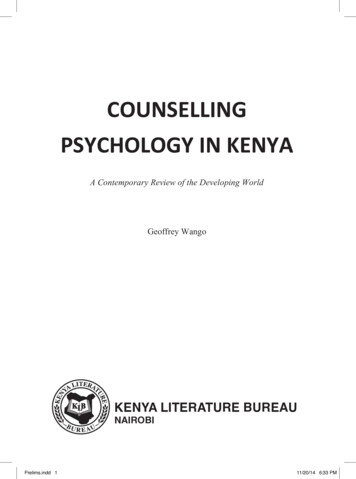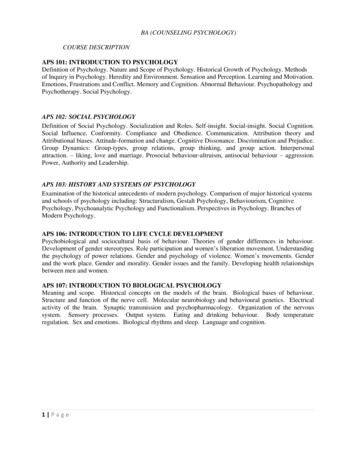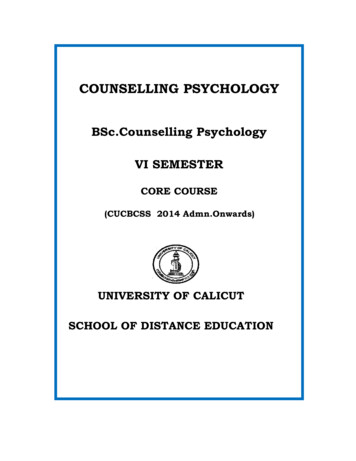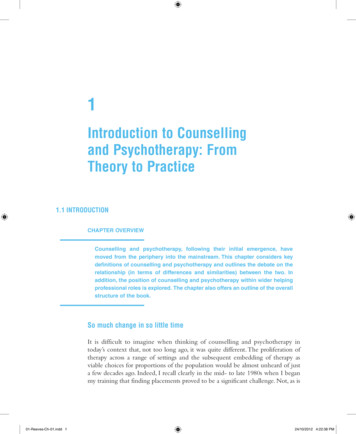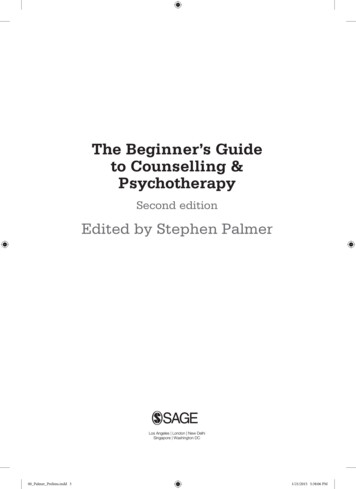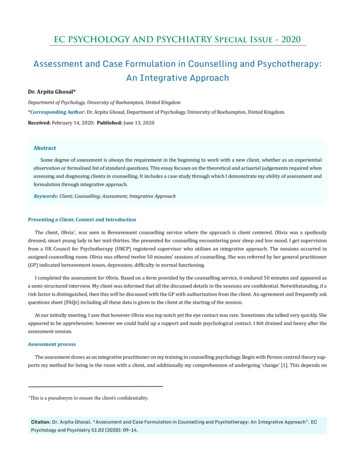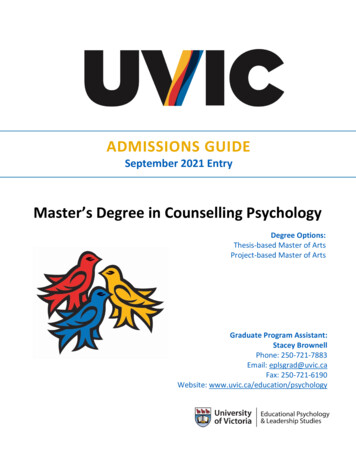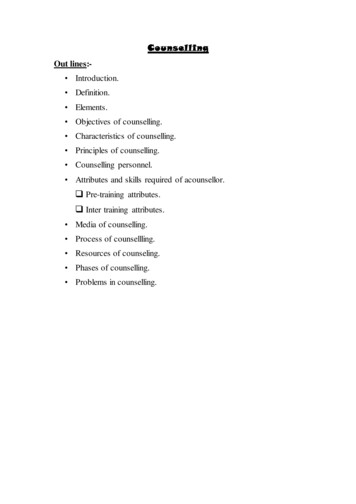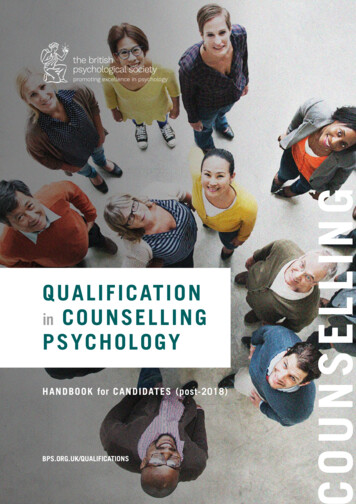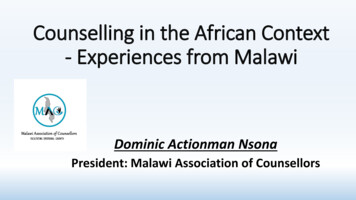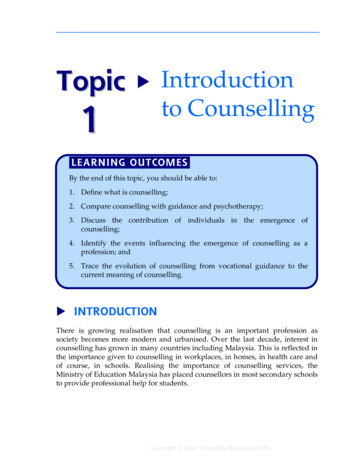
Transcription
TopicIntroductionto Counselling 1LEARNING OUTCOMESBy the end of this topic, you should be able to:1. Define what is counselling;2. Compare counselling with guidance and psychotherapy;3. Discuss the contribution of individuals in the emergence ofcounselling;4. Identify the events influencing the emergence of counselling as aprofession; and5. Trace the evolution of counselling from vocational guidance to thecurrent meaning of counselling. INTRODUCTIONThere is growing realisation that counselling is an important profession associety becomes more modern and urbanised. Over the last decade, interest incounselling has grown in many countries including Malaysia. This is reflected inthe importance given to counselling in workplaces, in homes, in health care andof course, in schools. Realising the importance of counselling services, theMinistry of Education Malaysia has placed counsellors in most secondary schoolsto provide professional help for students.Copyright Open University Malaysia (OUM)
2 TOPIC 1INTRODUCTION TO COUNSELLINGThe increasing interest in counselling may be attributed to the psychologicaland social ills arising from the stress of modern living and demands ofsociety. Everyday life can be challenging and stressful for even the mostresilient of children. Competition, bullying, racism, family crises, academicunderachievement, peer pressure, substance abuse, gangs, suicide and violenceare but a few of the problems faced by students. To cope with these problems,individuals have turned to counsellors and psychologists. Counselling as aprofession is now better managed and regulated and there is an improvedunderstanding of the benefits and limits of counselling practice.1.1THE EMERGENCE OF COUNSELLINGBefore the 1900s, most counselling was in the form of advice or information. Inthe United States, counselling developed out of a humanitarian concern toimprove the lives of those affected by the Industrial Revolution in the 1850s toaround the early 1900 (Figure 1.1). The social welfare reform movement,womenÊs right to vote, the spread of public education, and various changes in thepopulation makeup (such as the large entrance of immigrants) also influencedthe growth of counselling as a profession.Figure 1.1: Industrial revolution1.1.1Pioneers of CounsellingCounselling gradually grew in the early 1900s; and three individuals credited aspioneers in counselling emerged and they are: Frank Parsons, Jesse B. Davis andClifford Beers. These three personalities identified themselves as teachers andsocial reformers. They focused on helping children and young adults learn aboutthemselves, about others, and the world of work. Their work was built on theidea of moral instruction, on being good and doing right, as well as dealing withCopyright Open University Malaysia (OUM)
TOPIC 1INTRODUCTION TO COUNSELLING 3intrapersonal and interpersonal relations. These were turbulent times and theysaw that American society needed help and took steps to do something.(a)Frank Parsons (1854ă1908)Frank Parsons is often considered as the „Father of Guidance‰. He wastrained in multiple disciplines, being a lawyer, an engineer, a collegeteacher, and a social worker before becoming a social reformer and workingwith youth. He was characterised as a broad scholar, a persuasive writerand a tireless activist. He is best known for founding the Boston VocationalBureau in 1908, a major step in the institutionalisation of vocationalguidance.At the Bureau, he worked with young people who were making decisionsabout their career. In his book, Choosing a Vocation, which was publishedin 1909 (one year after his death), he developed a framework to helpindividuals decide on a career, as outlined below:Frank ParsonsÊ Steps for Choosing a Career1. First, the person should have a clear understanding of his or heraptitudes, abilities, interests and limitations (Self-Assessment).2. Next, the person should be aware of available job opportunities, therequirements and demands of the work, the compensations givenand prospects of the job (Study of Options).3. Finally, match or establish a relationship between these two bodiesof information, for example, the abilities of the person andcharacteristics of the job (Careful Reasoning).ACTIVITY 1.1The questions below were asked by Parsons in the 1900s:ĆAre your manners quiet, noisy, boisterous, deferential, or selfassertive? Are you thoughtful of the comfort of others?ĆDo you smile naturally and easily, or is your face ordinarilyexpressionless?ĆAre you frank, kindly, cordial, respectful, courteous in wordsand actions?Copyright Open University Malaysia (OUM)
4 TOPIC 1INTRODUCTION TO COUNSELLING What are your powers of attention, observation, memory,reason, imagination, inventiveness, thoughtfulness, receptiveness,quickness, analytical power, constructiveness, breadth, grasp? Can you manage people well? Do you know a fine picture when you see one? Is your will weak, yielding, vacillating, or firm, strong, stubborn? Do you like to be with people and do they like to be with you?1. Comment on the questions asked by Parsons in attempting to gaininformation about the individualÊs abilities and personality.2. Did you choose your career based on ParsonsÊ steps? Elaborate.According to Parsons, an ideal career choice should be based on matchingpersonal traits such as abilities and personality, with job characteristics suchas wages, requirements, prospects and so forth, through true reasoning.This is more likely to ensure vocational success. His framework later becamethe popular „Trait-Factor Theory‰ in career guidance (which is still usedtoday). Parsons created procedures to help his clients learn more aboutthemselves and the world of work. He designed an extensive questionnairethat asked about clientsÊ experiences, preferences and moral values.The idea of having vocational counsellors was implemented in manyprimary and secondary schools in the Boston area and it gradually spreadto other major cities in the United States. By 1910, 35 cities had followedBostonÊs lead. According to Samuel Gladding, President of the AmericanCounselling Association, besides his theory:„Parsons might best be remembered for emphasising that in life we havechoices. If we wish, we may cower and resign ourselves to fate. Anapproach of this type might be justified given the world in which we live.However, Parsons not only highlighted the importance of choice, but calledattention to the significance of meaningfulness in life. It was Parsons whostressed that it is better to find something to do that is meaningful than toentrust your life to the whims of chance and the will of others.‰ă Samuel GladdingSource: American Counselling Association, 2002Copyright Open University Malaysia (OUM)
TOPIC 1(b)INTRODUCTION TO COUNSELLING 5Jesse B. DavisJesse B. Davis was the first person to set up a systematic guidanceprogramme in public schools. Being the superintendent of Grand RapidsMichigan school system, Davis suggested teachers of English compositioninclude topics on career guidance in their lessons once a week, with thepurpose of building character to lessen student problems. Davis believedthat proper guidance would help cure the ills of American society due torapid urbanisation and industrialisation. What he and other progressiveeducators advocated was not counselling as known today, but more of thebeginning of counselling called school guidance, which refers to apreventive educational means of teaching students how to deal effectivelywith life.Counselling was conceived as a tool or technique to assist in the guidanceprogramme. Between 1914 and 1918, school guidance programmes wereinitiated in several large cities around the United States.Davis highlighted prevention and preparation for life and services wereprovided to both males and females and people from all backgrounds(Remember, this is America in the 1900s where equal rights was still anascent idea). From this initiative by Davis, guidance programmes grew inAmerican schools which later evolved into comprehensive schoolcounselling programmes that addressed three basic areas, namely: academicdevelopment, career development, and personal/social development.(c)Clifford BeersClifford Beers, a former Yale student suffered from severedepression and paranoia several times during his life. Aftera failed attempt at suicide, he was committed to an institutefor the insane, and remained in such asylums for threeyears. He found conditions in mental institutionsdeplorable and exposed them in his book, A Mind ThatFound Itself in 1908. The book became an instant best seller.Beers used the book as a platform to advocate for betterCliff Beersmental health facilities and reform in the treatment of thementally ill by making friends with and soliciting funds from influentialpeople of his day, such as the Fords and the Rockefellers. BeersÊ work hadan especially powerful influence on the field of psychiatry and clinicalpsychology. BeersÊ work engineered the mental health movement in theUnited States, as well as advocacy groups that exist today including theNational Mental Health Association and the National Alliance for theMentally Ill. His work was also a forerunner of mental health counselling.Copyright Open University Malaysia (OUM)
6 TOPIC 1INTRODUCTION TO COUNSELLINGSELF-CHECK 1.1Explain the contributions of Parsons, Davis and Beers in thedevelopment of the counselling profession.1.1.2Events that Influenced the Development ofCounselling (1900-1930s)Besides the three pioneers in counselling, the first decade of the 1900s also sawcertain events that had a significant impact on the development of counselling;namely, the founding of the National Vocational Guidance Association in 1913,the Congressional passage of the Smith-Hughes Act in 1917 and World War I.(a)National Vocational Guidance AssociationThe National Vocational Guidance Association (NVGA) was founded in1913 and began publishing the National Vocational Guidance Bulletinwhich was later renamed the National Vocational Guidance Magazine in1924 and the Vocational Guidance Journal in 1952. In 1984 it was renamedthe Journal of Counselling and Development. Note how the emphasisshifted from „vocational guidance‰ towards „counselling‰. This was due tothe growing complexities of modern living in urbanised environmentswhich prompted the realisation that the role of counsellors should gobeyond just providing vocational guidance.(b)The Smith-Hughes Act of 1917The second event was the passing of the Smith-Hughes Act by Congress in1917. This act provided funding for public schools to support vocationaleducation. This signifies the importance attached to counselling inAmerican schools.(c)World War IThe third important event contributing to the development of counsellingwas World War I. During the war, counselling was used in testing andplacement for great numbers of military personnel. In this process, theArmy commissioned the development of numerous psychologicalinstruments including the Army Alpha and Army Beta intelligence tests.Various screening devices were employed and psychological testingbecame a popular movement and early foundation on which counsellingwas based.Copyright Open University Malaysia (OUM)
TOPIC 1INTRODUCTION TO COUNSELLING 7SELF-CHECK 1.2Trace the events that had a significant impact on the development ofcounselling.Education, Certification and InstrumentsThe 1920s was a period of consolidation for the counselling profession. Educationcourses were initiated in Harvard University in 1911, emphasising vocationalguidance. The dominant influences were the progressive theories of educationand the federal governmentÊs use of guidance services with war veterans.Counsellors in Boston and New York were given certification. Anothersignificant event was the development of the first standards for the preparationand evaluation of occupational materials. These were supplemented with thepublication of new psychological instruments such as the Edward StrongÊsStrong Vocational Interest Inventory (SVII) in 1927, which became a foundationfor the use of assessment in counselling.Two years later, the first marriage and counselling centre was established in NewYork City by Abraham and Hannah Stone. This was soon followed by the settingup of such centres across the country. This marked the beginning of marriageand family counselling as a specialisation of counselling. While the guidancemovement gained acceptance by American society, the movementÊs narrowemphasis on vocational interests began to be challenged. Counsellors werebroadening their focus to include issues relating to marriage and family.First Theory of CounsellingThe 1930s was the era of the Great Depression. This raised the need for helpingstrategies and counselling methods related to employment. The first theory ofcounselling was formulated by E. G. Williamson and his colleagues at theUniversity of Minnesota. Williamson modified ParsonsÊ theory and used it towork with students and the unemployed. His emphasis on a direct counsellorcentred approach became known as the Minnesota point of view and sometimesreferred to as the trait-factor counselling. His pragmatic approach emphasisedthe counsellorÊs teaching, mentoring and influencing skills.Williamson proposed that all individuals have traits such as aptitudes, interests,personalities and achievements that could be integrated in a variety of ways toform factors (a group of individual characteristics). Counselling was based onscientific, problem-solving, empirical method that was individually tailored toeach client to help him or help stop non-productive thinking or behaviour, thusbecoming an effective decision maker. Williamson believed that the job of theCopyright Open University Malaysia (OUM)
8 TOPIC 1INTRODUCTION TO COUNSELLINGcounsellor was to ascertain a lacking in the client, and then prescribe a procedureto rectify the problem. Williamson continued to write about his theory until the1970s.Every teacher should be a counsellor and guidance should focus on preparingstudents to live outside the school environment.ă John Brewer, 1932Another significant development in the 1930s was the broadening of counsellingbeyond occupational concerns. Back in the 1920s, Edward Thorndike and otherpsychologists began to challenge the vocational orientation of the guidancemovement. John Brewer continued the emphasis on extending counselling toother specialties when he published a book in 1932 titled Education as Guidance.Brewer proposed that every teacher should be a counsellor and guidance shouldfocus on preparing students to live outside the school environment. Thisemphasis made counsellors see vocational decisions as part of theirresponsibilities.The American government also became more involved in guidance andcounselling. Congress passed the George-Dean Act in 1938 that created theVocational Education Division of the U.S. Office of Education. State supervisorsof guidance positions in state departments of education were elected throughoutthe country. Therefore, school guidance became a national phenomenon. Thegovernment also established the U.S. Employment Service in the 1930s, whichpublished the first edition of the Dictionary of Occupational Titles (DOT) in 1939.The DOT became a major source of career information for guidance specialistsworking with students and the unemployed which described known occupationsin the United States and coded them according to job titles.1.1.3Counselling in the 1940sThree major events in the 1940s radically shaped the practice of counselling. Thefirst event was the practice of counselling by Carl Rogers who published his bookCounselling and Psychotherapy in 1942.Copyright Open University Malaysia (OUM)
TOPIC 1(a)INTRODUCTION TO COUNSELLING 9Carl RogersRogers challenged WilliamsonÊs counsellor-centredapproach as well as the theory of Sigmund Freud whoproposed the psychoanalysis approach. Rogersbelieved in non-directive approach to counselling,emphasising the responsibility of the client for growthand choice (we will explore this theory in Topic 3:Counselling Theories).He believed that if clients were accepted and listenedto, they would begin to know themselves better andCarl Rogersbecome genuinely in harmony. He pictured the role of1902ă1987the counsellor as being non-judgemental andaccepting. The counsellor should act as a mirror, reflecting the verbal andemotional concerns of clients. Before Carl Rogers, the counselling emphasiswas on vocational guidance, psychometric testing, and orientationprocedures. Rogers introduced a new emphasis on techniques and methodsof counselling itself, research, and refinement of counselling techniques,selection and training of future counsellors, and goals and objectives ofcounselling. Guidance suddenly disappeared from counselling and wasreplaced by full concentration on counselling.(b)World War IIThe second event was World War II during which the U.S. governmentneeded counsellors and psychologists to help select and train specialists formilitary and industry. Many women started to work outside the home asmen went to war. Traditional occupational sex roles began to change andgreater emphasis was put on personal and gender freedom.(c)Involvement of the American GovernmentThe third impetus for the development of counselling was the AmericangovernmentÊs involvement in counselling after the war. The governmentfurther promoted counselling when it passed the George-Barden Act in1946, which provided vocational education funds through the U.S. Office ofEducation for counsellor training. The Veterans Administration (VA) alsogranted stipends and paid internships for students engaged in graduatestudy. The VA rewrote specifications for vocational counsellors and coinedthe term „counselling psychologist‰. The funds greatly influenced teachingprofessionals in graduate education to define their curriculum offeringsmore precisely. Counselling psychology as a profession began to movefurther away from its historical alliance with vocational guidance.Copyright Open University Malaysia (OUM)
10 TOPIC 1INTRODUCTION TO COUNSELLINGSELF-CHECK 1.31. What was Carl RogersÊ argument?2. How did government involvement impact the development ofcounselling in the 1940s?1.1.4Counselling in the 1950sThe 1950s saw dramatic changes to counselling. The Council of Guidanceand Personnel Associations (CGPA) which operated from 1934 to 1951 wasrenamed The American Personnel and Guidance Association (APGA) in 1952.The Association was formed with the purpose of formally organising groupsinterested in guidance, counselling, and personnel matters. About 6000associations registered with the APGA, which early in its history was an interestgroup rather than a professional organisation since it did not originate or enforcestandards for membership.Another development was the establishment of the Division of CounsellingPsychology (Division 17) within the American Psychological Association (APA)in 1952. This division dropped the term guidance from its formal name. The ideaemerged from APA members who wanted to work with a more „normal‰population than the one seen by clinical psychologists. Super (1955) argued thatcounselling psychology was more concerned with normal human growth anddevelopment. Despite SuperÊs work, counselling psychology had a difficult timeestablishing a clear identity within the APA, yet its existence had a major impacton the growth and development of counselling as a profession.The 1950s saw the passing of the National Defence Education Act (1958) whichaimed to identify and develop scientifically and academically talented students.It also saw the establishment of counselling and guidance institutes to traincounsellors. In 1952, the field of school counselling attained the status of aprofession with the formation of the American School Counsellor Association.The Ê50s also witnessed the introduction of new theories on guidance andcounselling. Before 1950, four major theories influenced the work of counsellors:(a)Psychoanalysis and insight theory,(b)Trait-factor or directive theories,(c)Humanistic and client-centred theories, and(d)Behavioural theories.Copyright Open University Malaysia (OUM)
TOPIC 1INTRODUCTION TO COUNSELLING 11Aubrey argued that counselling should be organised and implemented in adevelopmental fashion. Teachers alone could not provide the necessary experiencesrequired for optimal development of students, and guidance programmes werethe most critical educational factor in enhancing student development (as cited inBauman et. al., 2003).Counsellors often debated whether to use directive (proposed by E. G. Williamson)or non-directive approach (proposed by Carl Rogers) in counselling. However,almost all counsellors agreed that certain assumptions of psychoanalysis wereacceptable. Gradually, the debate shifted as new theories emerged. For example,applied behavioural theory, rational-emotive therapy, transactional analysisand research in career development and developmental psychology, contributedtremendously to the expansion of counselling in terms of its resources of theoriesand approaches.SELF-CHECK 1.4What was the main argument for setting up the Division of CounsellingPsychology within the American Psychology Association?1.1.5Counselling in the 1960sIn his book Revolution in Counselling, published in 1962, John Krumboltzemphasised behavioural counselling which emerged as a strong counsellingtheory. He also promoted learning as the agent of change. These were turbulenttimes during which the civil rights movement, womenÊs rights movement andprotests against the Vietnam War were most active (see Figure 1.2). These issuesled to a shift in the focus of counselling from a developmental approach towardsaddressing social crisis issues. More community mental health centres wereestablished all over the United States. Counselling began to spread to involvealcohol abuse counselling, addiction counselling, and family counselling. Also,during this decade, group counselling began to gain popularity as a way ofresolving personal issues.Copyright Open University Malaysia (OUM)
12 TOPIC 1INTRODUCTION TO COUNSELLINGFigure 1.2: Protest during the 1960sIn 1961, American Personnel and Guidance Association published its first code ofethics. The role definitions and training standards for school counsellors werefurther clarified. Also, a definition of counselling psychology agreed upon by theAmerican Psychology Association followed by the publication of The CounsellingPsychologist Journal with Gilbert Wrenn as its first editor in 1964. In 1966, ERICClearinghouse on Counselling and Personnel Services (CAPS) at the Universityof Michigan was founded. It was responsible for building a database of researchin counselling. It has become one of the largest and most used resources oncounselling activities and trends in the United States and throughout the world.1.1.6Counselling in the 1970s and 1980sThe 1970s saw the field of counselling extending its specialties outside theeducational settings. As more counsellors graduated from colleges anduniversities, competition grew. Specialised training began to be offered incounsellor education programmes. New concepts of counselling were introduced.In 1977, Lewis and Lewis coined the term community counsellor to describe acounsellor who could function in various roles regardless of where he or sheworks. In 1976, the American Mental Health Counselling Association was formedand became one of the largest divisions within the American Personnel andGuidance Association. The Association started its own method of licensingcounselling graduates which led towards standardised training and certificationand the formation of the Council for Accreditation of Counselling and RelatedEducational Programs (CACREP) in 1981.This council standardised counsellor education programmes for masters anddoctoral programmes in the areas of school, community, mental health, familyand marriage counselling.In 1983, the National Board of Certified Counsellors (NBCC) was established inorder to certify counsellors at a national level. It developed a standardised testCopyright Open University Malaysia (OUM)
TOPIC 1INTRODUCTION TO COUNSELLING 13and determined eight areas for counsellors to be proficient in: human growthand development, social and cultural foundations, helping relationships,groups, lifestyle and career development, appraisal, research and evaluation, andprofessional orientation. Besides passing the test, candidates had to meetexperiential and character reference qualifications. There was a growing awarenessamong APGA leaders regarding the inappropriate usage of the term personneland guidance as the counselling profession had developed beyond its originalfocus. Thus, in 1983, the APGA changed its name to the American Association forCounselling and Development (AACD).SELF-CHECK 1.5What were the developments in the 70s and 80s that contributedtowards making counselling more of a profession?1.1.7Counselling in the 1990s and OnwardsIn 1992 the AACD changed its name to the American Counselling Association(ACA). During that year, counselling was put on par with other mental healthspecialties such as psychology, social work, and psychiatry. The field ofcounselling addressed topics such as spiritual issues, multicultural counsellingand family influences more openly. The 1990s saw an increase in the numberof programmes in counsellor education and counselling psychology at bothdoctoral and master levels, as well as an increase in the number of professionalpublications on counselling.The 21st century saw a new emphasis on counsellors dealing with crises, trauma,and tragedies as a result of heightened violence in schools, abuse, naturaldisasters and terrorist attacks. The focus of counselling shifted to the effects andtreatment of stress. Another emphasis is the promotion of wellness in physical,intellectual, social, psychological, emotional and environmental life of theindividuals. Counselling has even extended its services over the Internet asevidenced with the availability of on-line counselling websites. Counsellors inthe United States today identify more with the American Counseling Associationas their professional organisation.Summing UpThe purpose of tracing the counselling movement in the United States is to showhow the field of counselling has evolved over the last century. It began as „givingadvice‰, moving towards „vocational guidance‰ and finally as „counselling‰.In Malaysia, it began as the Malaysian Vocational Guidance AssociationCopyright Open University Malaysia (OUM)
14 TOPIC 1INTRODUCTION TO COUNSELLING(MAVOGA) which later evolved into the Malaysian National CounsellingAssociation.1.2WHAT IS COUNSELLING?Advertisement in a NewspaperDue to our expansion, we invite dynamic and highlymotivated individuals to fill the following position:Sales CounsellorĆGood communication and interpersonal skillsĆAble to work flexible hours including weekendsWhile there is increasing acceptance of counselling, there is also misuse andoveruse of the term, as exemplified in the newspaper advertisement above.Certain individuals are calling themselves „counsellors‰ and certain groupsand organisations are labelling their services as „a counselling service‰. Toprotect the integrity of the profession, there is a need to correct misconceptionsand minimise misuse of the term among members of the public. In this courseyou will learn what counselling is, counselling theories, the counselling process,the skills of the counsellor and the issue of ethics, but, you cannot claim to be aprofessional counsellor. You need much more knowledge about the professionand have a great deal of practical experience. However, as an educationist it isnecessary that you are equipped with the basics of counselling. Many a time asan educator, you deal with students encountering various kinds of mental healthrelated problems. If you do „fall in love‰ with the profession after this course,you can work towards becoming a professional counsellor by taking morecourses in the field and doing internships.ACTIVITY 1.2Look for newspapers articles, magazines and posters that have usedthe term counsellor.What do they mean by counsellor in these instances?The word counselling stems from the verb „to counsel‰ which has always meant„to advise‰. So it is not surprising that some people still have this misconceptionCopyright Open University Malaysia (OUM)
TOPIC 1INTRODUCTION TO COUNSELLING 15of counselling. Although some forms of counselling may contain some advicegiving components, counselling is mostly dedicated to restoring a clientÊs selfunderstanding, decision-making resources, risk-taking and personal growth.Telling people what to do can be a counterproductive remedy. Basically,counselling is a short-term, theory-based, non-directive, non-judgemental process.During this process, a psychologically healthy person called the client, is facingan adjustment in dealing with a developmental or situational problem. The clientwants to gain an awareness of himself or herself and to make decisions throughthe support and assistance offered by another person called the counsellor.Bor et. al. (2002) emphasise that counselling is not a process of „doing somethingto someone‰, thus:Counselling is an interaction in a therapeutic setting, focusing primarily on aconversation about relationships, beliefs, and behaviour (including feelings),through which the clientÊs perceived problem is elucidated and framed orreframed in a fitting or useful way, and in which new solutions are generatedand the problem takes on a new meaning (p. 19).This definition has many aspects to it. First, it describes counselling as an„interaction in a therapeutic setting‰. The dictionary meaning of „therapeutic‰is healing, curative, beneficial or remedial. Sec
TOPIC 1 INTRODUCTION TO COUNSELLING 2 The increasing interest in counselling may be attributed to the psychological and social ills arising from the stress of modern living and demands of society. Everyday life can be challenging and stressful for even the most resilient of childre
